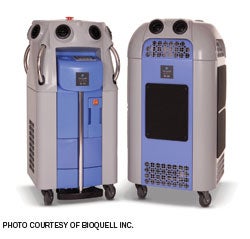Johns Hopkins finds vaporizers cut risk of contamination
 |
| A hydrogen peroxide vaporizer and catalytic converter can cut the risk of patient contamination from multidrug-resistant organisms. |
Johns Hopkins Hospital, Baltimore, is using hydrogen peroxide vaporizers (HPV) to disinfect some intensive care units after an 18-month study determined the technology reduces the risk of patients' acquisition of multidrug-resistant organisms (MDRO) compared with standard cleaning protocols.
The study showed that use of an HPV system combined with a catalytic aerator that detoxifies the disinfecting chemical reduced by 64 percent the number of patients who later became contaminated with any of the most common multidrug-resistant organisms. Patients were 80 percent less likely to acquire vancomycin-resistant enterococci, according to the study.
In the study, which was conducted from January 2008 through June 2009, the prior occupants of the patient rooms were known to be infected or colonized with an MDRO in 22 percent of 6,350 admissions in 180 private patient rooms. Nearly half of the rooms in the study were disinfected using HPV.
After the study rooms underwent regular cleaning, the vents inside the rooms were covered, the two devices were placed inside and the rooms were sealed. The vaporizer dispersed hydrogen peroxide into the rooms, leaving a layer 2 to 6 microns in thickness on all exposed surfaces. The HPV process was tracked with electronic monitors outside the rooms.
After the first step was completed, a catalytic aerator unit converted the hydrogen peroxide vapor to water vapor and oxygen and left a residue-free surface and safe environment. Hydrogen peroxide can be toxic if ingested or corrosive if left on skin too long. The entire process takes about 90 minutes.
"Hydrogen peroxide vapor, as spread around patients' rooms by these devices, represents a major technological advance in preventing the spread of dangerous bacteria inside hospitals and, especially, from one patient occupant to the next," says Trish Perl, M.D., senior epidemiologist, the Johns Hopkins Health System and Johns Hopkins Medicine.
Perl says the study offers evidence that "technological solutions, when combined with standard cleaning, can effectively and systematically decontaminate patients' rooms and augment other behavioral practices, such as strict hospital staff compliance with hand washing."
Johns Hopkins has purchased two disinfecting units and aerators, which cost more than $40,000 per pair. The hospital plans to use the technology to decontaminate rooms that typically house high-risk patients under strict isolation precautions because of severe infection with a multidrug-resistant organism.
"What is so exciting about this new method of infection control is that the devices are easy to use and hospital staff embrace the technology very quickly," according to surgeon and study co-investigator Pamela Lipsett, M.D.



